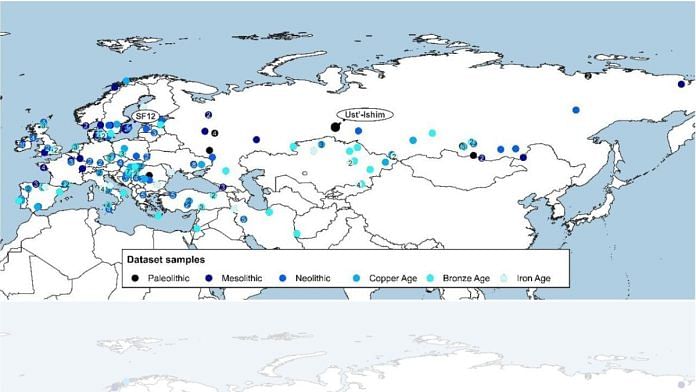New Delhi: The colour of eyes, hair, and skin among Eurasians and Africans is no longer a mystery. The evolution of light skin, hair, and eyes in Eurasia occurred over thousands of years, influenced by natural selection of genes and complex migration, reveals a new preprint study.
“The shift towards lighter pigmentation turned out to be slower than expected, with half of the individuals showing dark or intermediate skin colours well into the Copper and Iron Ages,” wrote the researchers in the study.
Researchers from the University of Ferrara, Italy, have used ancient DNA evidence to understand the natural colour of skin, eyes, and hair in humans from Eurasia. The study analysed DNA samples ranging from 45,000 to 1,700 years old, representing about 34 countries.
Ancient DNA samples are often incomplete, making accurate predictions difficult. Previous studies that have traced the evolution of skin colour have relied on the HIrisPlex-S system. This system studies DNA to predict eye, skin, and hair colour. Though it works well for the European population, its accuracy is lower for people with mixed ancestry.
This methodological limitation was addressed in this study, where researchers made predictions using a probabilistic method. In this method, DNA profiles were inferred using statistics and computer algorithms. This approach was tested on two well-preserved ancient human DNA samples—Ust’-Ishim from Russia and SF12 from Sweden.
Researchers have emphasised that skin, eye, and hair colour depend on different amounts, types, and distribution of two pigments—eumelanin, responsible for brown and red shades; and pheomelanin, responsible for brown and yellow shades.
These are the primary types of melanin pigments that determine human appearance and offer protection against UV radiation. These pigments play a crucial role in shielding the skin from Sun damage while also influencing physical traits.
This study expands the understanding of the “evolutionary and demographic forces that shaped modern human phenotype variation”—explaining how and why people develop different skin, hair, and eye colours.
Evolution of skin colour
Scientists found that the first humans in Eurasia were dark-skinned and dark-haired, originating from warm climates. These darker-skinned humans had more melanin—a pigment that blocks the UV rays the body uses to produce vitamin D—compared to their lighter-skinned kin in the evolutionary cycle.
Vitamin D, in turn, is crucial for bone health and strengthening the immune system, as well as aiding calcium absorption and muscle function.
By the Iron Age (1200 BC to 500 BC), light-skinned people became as common as dark-skinned ones, with gene flow being the major driver of change, as noted by the researchers in the study.
The Neolithic farmers from Anatolia, present-day Turkey, “profoundly changed the genetic makeup of populations,” write the researchers, leading to a “population turnover”.
These farmers had two key advantages over the local hunter-gatherers: a stable food supply ensured by farming and animal herding, and a lighter skin tone. A lighter skin tone is better adapted to northern regions where the intensity of UV rays is low, as low melanin content in lighter skin helps produce more vitamin D.
These advantages enabled the farmers’ population to grow at a faster rate than the local hunter-gatherers, causing a major shift in the appearance of Europeans.
However, the migration of Neolithic farmers was not the sole cause of the transformation of skin colour in Europe. The researchers have attributed this transformation to a localised process of migration and interbreeding of different isolated populations.
(Edited by Radifah Kabir)
Also Read: Fossil of extinct human species Denisovan identified in Tibetan plateau, their diet pattern revealed




